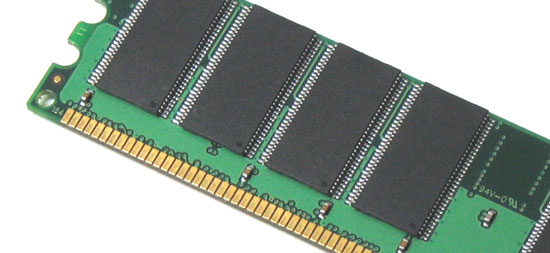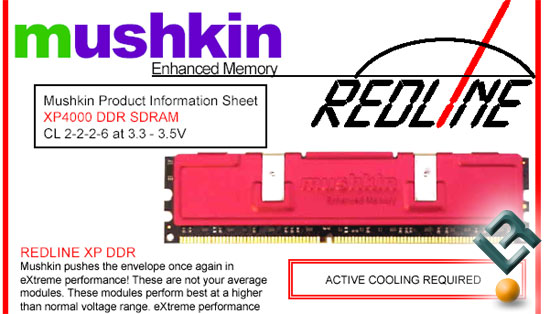Behind Closed Doors: UTT Memory IC’s Explained
UTT Memory IC’s Explained
The Ethusiasts Are Wanting UTT DDR1 Memory IC’s, But Does Anyone Know What They Are?
In recent weeks it seems that every hardware enthusiast has been asking about UTT based memory modules. Everyone that brings up UTT memory modules such as OCZ’s VX Memory thinks these are new and super fast IC’s that just hit the market. These “new” IC’s are based off the old Winbond die revisions, and the term UTT is nothing new for those in the memory industry. What consumers don’t understand is that Infineon recently DUMPED these IC’s on the market for a number of reasons. Today, Legit Reviews takes a closer look at the newest trend in the enthusiast memory maket.
For starters, do you know what UTT stands for? It stands for UnTesTed memory IC’s. This means that after the IC’s were packaged they were NOT speed binned and offer no ratings from the factory. This is done so DRAM manufacturers can cut 15 to 20 percent in costs per DRAM by skipping DRAM chip reliability burn-in and speed/functionality testing on high-end chip testers. Not only does this save money, but it also allows them to dump large volumes of IC’s on the market faster because there is no testing done. Is this a good idea? For those looking to build systems that meet JEDEC specifications, it is bad news because the majority of these IC’s are Non-Conforming (NC). For system builders or corporate builders these IC’s are known to be bottom of the barrel and are something they wouldn’t touch with a ten foot pole. This is why these UTT IC’s come blank from the factory with nothing written on them as they are unrated. Below is an image of OCZ’s PC-3200 Gold VX modules without the heatspreaders installed. Note the lack of any IC labeling from the manufactuer.

What happens next is that the DRAM manufacturers then sell the UTT DRAMs to brokers who then dump them off different memory markets around world (Don’t forget they make some money and mark them up a bit). Then third-party memory module manufacturers buy them and build low-cost modules using the BrainPower PCB’s (which are cheaper to build than the JEDEC reference design). These third-party memory builders are often known as the “sticker” or “re-label” companies. The modules are then sent to the local warehouse and then sold directly to the consumer. No real in-depth testing takes place during this whole process! Modules that are built on this process can be found for as little as $10 per 512mb module in Asia and $50 here in the United States.
Now you know the UTT IC’s are untested and basically the cheapest IC’s that can be purchased on the market! Currently we are seeing companies here in the United States starting to sell UTT DRAM modules for as high as $300 and offering DDR500 2-2-2 performance levels. How can this be done on these bottom barrell IC’s? Turns out many companies are using RST Pro2 tester cards for platform testing or sending them out to be screened. They are also using massive amounts of voltage to produce these results. An example of this is the new Mushkin Redline PC-4000 memory modules that are rated to run 2-2-2 timings at 3.5V. Most motherboards can’t even run 3.5 Volts, unless you have the DFI Lanparty series or the upcoming Sapphire boards.
Let’s take a look at the product information sheet on the Mushkin Redline series that just came on the market today. See if you notice anything interesting on this cropped section!

For the first time in DDR1 memory history, we are seeing the words “Active Cooling Required” for enthusiast memory modules. Meaning you better get out that fan or water cooling kit for your memory as passive air cooling is no longer enough! We asked Mushkin to define the amount of active cooling that is needed on their latest part and got this in reply.
Due to the extreme speed of these modules along with the added voltages used, Mushkin requires end users to actively cool their memory modules. Modules that are not properly cooled will/may not meet rated timings and speeds, and may become susceptible to premature failure. We generally recommend 15-25cfm of direct airflow over the ram modules which can be easily accomplished with one 60mm or 80mm low rpm fan. This will insure increased stability and lifespan of your Redline modules.
Mushkin has a lifetime warranty on their modules, but flat out say that without active cooling they may not even reach their rated timings and speeds. Not to mention the lifespan of the modules are reduced by running high voltages without proper cooling. Both Corsair and Kingston have told Legit Reviews that they are holding off on high voltage memory modules due lack of platforms that support these voltages, warranty issues, and the lack of JEDEC support.
Nathan Kirsch’s Thoughts:
Hopefully after reading this in-depth article on UTT memory IC’s you are now a better informed consumer and know what comapnies are doing behind the scenes. Numerous companies are building modules with UTT IC’s and Brainpower PCB’s and are cranking out some memory modules that are running at some amazing speeds and timings. Legit Reviews is hitting over 500MHz at 2-2-2 timings on some of our testing samples and are impressed by what can be achieved from UTT IC’s. At the same time LR is a bit bummed by the high prices these modules carry. As we already covered in this aritcle that these modules are built using some of the cheapest parts on the market and for a part that can be bought for $10 overseas we are seeing them priced close to $300 in the United States. It would be nice if some memory companies passed along the savings to the consumer, but who knows how these modules will hold up down the road. With a lifetime warranty on memory running 3.5Volts possibly 24/7, we might be seeing a lot of burnt out modules one or two years from now. Don’t forget this is the first time we are seeing 3.2+ volts on motherboards and 3.5+ volts on DRAM as standards, so who knows the real lifespan of these products. Maybe the price is justified if the modules need to be RMA’d several times during their use.
For those that are curious here is a list of companies that currently offer UTT IC’s on some of their modules. As you can tell a number of companies are using these untested low cost IC’s on a number of different modules.
- Corsair
- Geil
- Kreton
- OCZ
- Mushkin
- Twinmos
- Vdata
With Active Cooling now required on memory modules get ready to start seeing new cooling designs over the quarter pop into the market. There has not been a major change in heat spreader design because there has been no need, but this will cause the market to adapt. I’m going out on a limb here, but I’m fairly certain we will see new water cooling blocks and fan cooling systems for memory modules to become something that enthusiasts will next be buying. (Joy, more money to spend)
Also, keep in mind that DDR2 has now become mainstream with AMD moving over later in the year, so it will no longer be for Intel platforms alone. Over in Asia DDR3 DRAM modules are already being built and tested. It looks like DDR3 DRAM modules will taking off around 1200MHz and is looking like it will happen in mid 2006 if everything keeps on track.

Comments are closed.